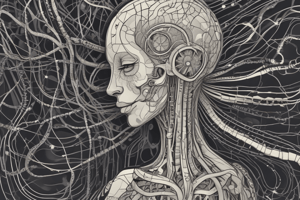Podcast
Questions and Answers
What is the primary function of the central nervous system?
What is the primary function of the central nervous system?
- To generate motor responses to sensory information
- To receive, process, and respond to sensory information (correct)
- To control the immune system
- To regulate blood pressure and body temperature
Which part of the brain is responsible for emotional and motivational responses?
Which part of the brain is responsible for emotional and motivational responses?
- Cerebrum
- Limbic system (correct)
- Brainstem
- Cerebellum
What is the function of the spinal cord in addition to conveying information between the brain and the body?
What is the function of the spinal cord in addition to conveying information between the brain and the body?
- Regulating blood pressure
- Generating motor responses
- Regulating lower bodily functions independently (correct)
- Controlling body temperature
Which of the following is NOT a part of the cerebrum?
Which of the following is NOT a part of the cerebrum?
What is the term for the bundle of nerve fibers that connects the two cerebral hemispheres?
What is the term for the bundle of nerve fibers that connects the two cerebral hemispheres?
Where is the spinal cord typically severed to avoid damage during lumbar punctures and spinal anesthesia in adults?
Where is the spinal cord typically severed to avoid damage during lumbar punctures and spinal anesthesia in adults?
Flashcards are hidden until you start studying
Study Notes
Nervous System Overview
- The nervous system consists of two main systems: Central Nervous System (CNS) and Peripheral Nervous System (PNS)
Central Nervous System (CNS)
- Responsible for receiving, processing, and responding to sensory information
- Composed of two organs: Brain and Spinal Cord
Brain
- Consists of: Cerebrum, Subcortical structures, Brainstem, and Cerebellum
- Cerebrum:
- Most prominent part of the brain
- Consists of two cerebral hemispheres interconnected by the corpus callosum
- Surface is highly irregular
- Cortex:
- Composed of gray matter with neurons and their supporting cells
- White matter:
- Composed of myelinated nerve fibers
- Subcortical structures:
- Neutral group of structures embedded deep within the brain
- Include: Thalamus, Hypothalamus, Basal ganglia, Limbic system, and Pituitary gland
- Basal ganglia:
- A group of structures involved in movement control and cognition
Spinal Cord
- Continues inferiorly from the medulla oblongata
- Consists of five segments: Cervical, Thoracic, Lumbar, Sacral, and Coccygeal
- A total of 31 pairs of spinal nerves emerge from it
- Functions:
- Conveys information between the brain and the rest of the body
- Regulates lower bodily functions independently from the brain, such as reflexes
- Ends at the level of vertebrae L1–L2
- Lumbar punctures and spinal anesthesia in adults:
- Usually performed between L3–L5 (cauda equina level) to avoid damage to the spinal cord
Studying That Suits You
Use AI to generate personalized quizzes and flashcards to suit your learning preferences.




